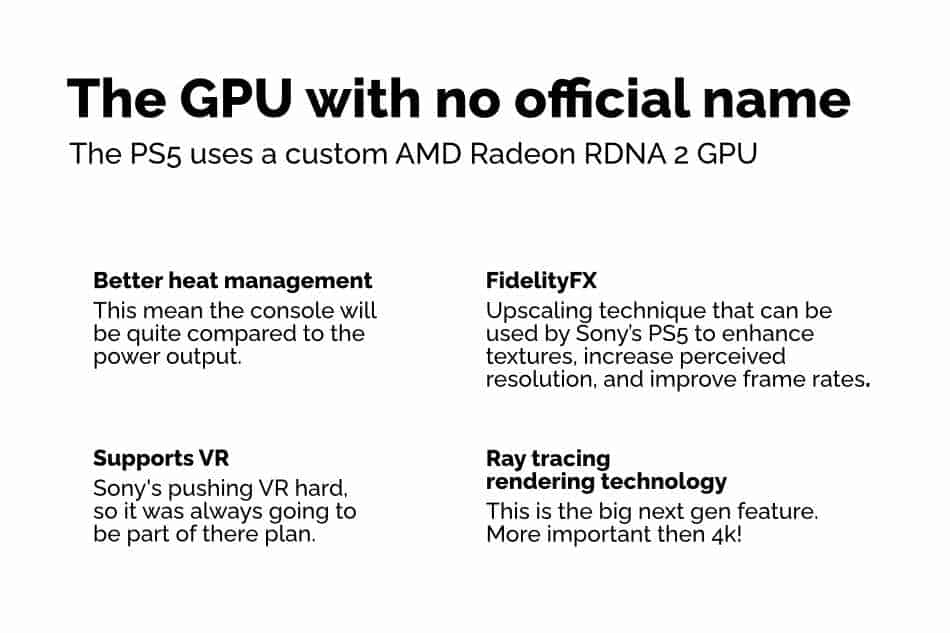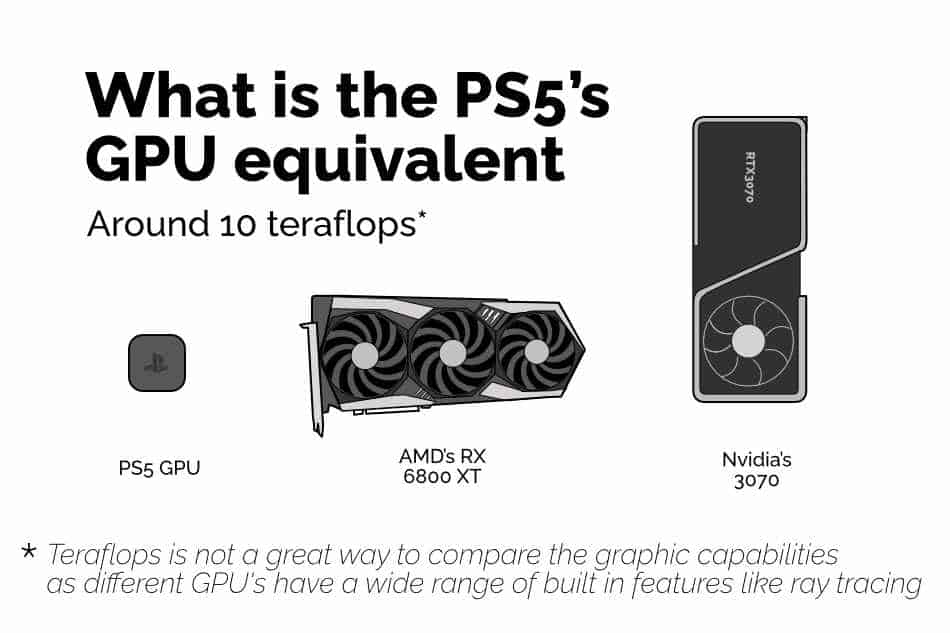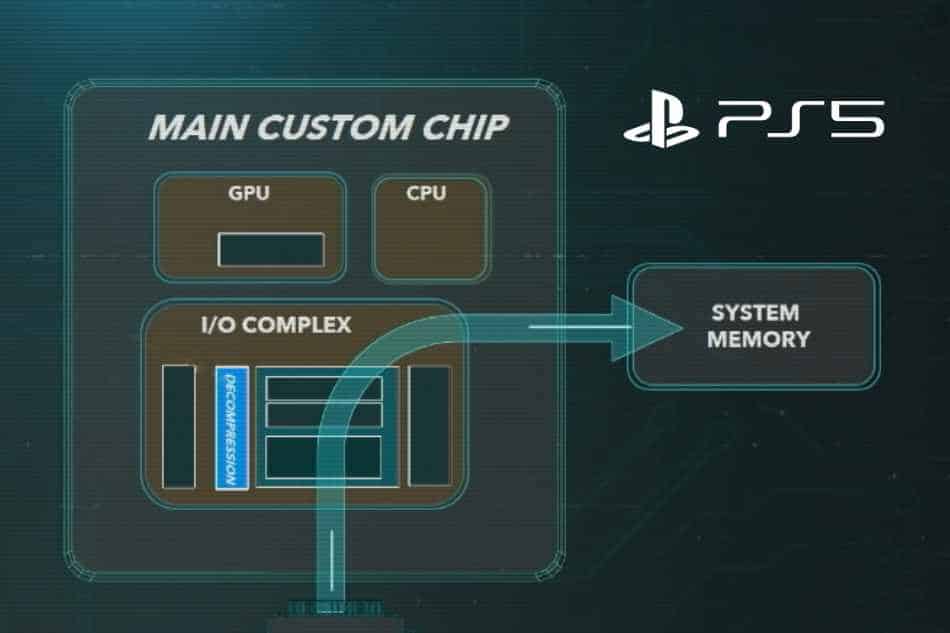After upgrading from a Full HD television to a 4K monitor for my PS5, and seeing the beauty of the gaming world in 4K, I was wondering what GPU the PS5 was rocking that enabled it to deliver such smooth and high-resolution gameplay.
Since a GPU is needed for displaying graphics and handling 4K at 60 FPS, a powerful GPU must be housed inside the PS5.
But what GPU is it? Nvidia? AMD?
Fueled by curiosity I jumped online to do some research, and this is what I found:
What GPU Does The PS5 Have? The PS5 doesn’t have a GPU that is available for PCs. Sony co-designed a custom AMD Radeon RDNA 2 GPU with variable frequency that goes up to 2.23GHz. It produces 10.28 teraflops of compute performance and has hardware-accelerated ray tracing. The GPU is also capable of displaying games at 4K 60fps.
I know what you must be thinking… “What in the name of Kratos is a Radeon RDNA 2 GPU?”
Well, you are in luck because I will answer that question along with the following questions:
- What features does the PS5’s GPU come with?
- What features does the PS5’s GPU not support?
- What is the PS5’s PC GPU equivalent?
- Can you upgrade the PS5’s GPU?
Ok, now you know what I’ll be talking about, let’s get started…
What Features Does The PS5’s GPU Come With?
RDNA 2 is actually the name of the GPU’s architecture and not the actual name of the graphics card itself. AMD released RDNA 2 technology for their RX 6000 series cards on PC. And PC users can vouch for the amazing performance of these cards.
RDNA 2 affords the PS5 GPU a few features that really help the PS5 stand out as a console. Let’s take a look at a few of them…
Better heat management
Since there is less room inside a console body and you have to make do with the cooling system provided. A GPU inside a console should be more power-efficient and give off less heat than a GPU in a PC, while there should be no compromise in performance.
Lots of R&D goes inside creating one of the most powerful console devices of this generation. Fortunately, Sony and AMD created an amazing GPU for the PS5 and didn’t charge their users an arm and a leg for it.
The PS5 graphics card is immensely powerful and pairs up with the AMD Zen 2 processor to provide the most amazing performance. Here are some of the features that you get with the RDNA 2 GPU:
FidelityFX
FidelityFX is a “shader-based” upscaling technique that can be used by Sony’s PS5 to enhance textures, increase perceived resolution, and improve frame rates.
The GPU Supports VR
The GPU inside the PS5 has to be VR-ready because PlayStation VR has to work.
Plus, there are a couple of leaks going around the web that indicate that PS5 VR might be on the way.
Ray tracing rendering technology
Ray tracing is a way for computers to graphically simulate the way real light bounces around a scene within a game.
This enables the game to simulate realistic shadows and light bounces. However, it’s typically a very expensive graphical technique that is only now seeing the light-of-day in real-time graphics.
The PS5’s GPU has purpose-built ray-tracing accelerators that enable real-time raytracing on the PS5.
More features will soon follow as Sony updates the PS5 firmware. However, there are still some features that the PS5’s GPU is still missing. Let’s check out what you’ll be missing out on.

What Features Does This GPU Not Support?
Though the PS5 has an extremely powerful feature-packed GPU, it is missing some key features. In the following section, I’ll take a look at some of the top features that the PS5’s GPU is missing. I shall also compare the PS5’s GPU to Microsoft’s Xbox Series X GPU to get an idea of the differences in feature sets.
There are no upgrade options
It is impossible to upgrade the PS5s GPU like you can on a PC. Therefore, the PS5s GPU has to last the entire PS5 generation.
You cannot alter graphics settings on a console
The GPU should be universal across all the consoles. It should be able to provide consistent levels of detail and frames on every single console any game is played on.
Less power
The Xbox Series X console’s GPU sports 12.1 teraflops compared to the PS5’s 10+ teraflops. This means that, on paper anyway, the Xbox Series X is 15% more powerful than the PS5. But that shouldn’t make that much of a difference in the real world.
For example, if the Xbox Was running at full 4k or 2160, the PS5 would only have to drop the resolution to 1836p to match the Xbox’s graphical detail and frame rate.
However, when compared to PC GPUs the PS5’s GPU lags massively behind. For example, Nvidia’s top-of-the-line GPU, the RTX 3090, offers a staggering 35.6 teraflops of compute power. That’s 3.5 times more powerful than a PS5!
DirectX Raytracing
The Xbox Series X GPU can make use of Microsoft’s proprietary DirectX ray-tracing (DXRT) capabilities which is a bit different from PS5’s Ray-tracing.
DXRT is a more mature software technology than Sony’s own custom ray tracing solution.
DLSS
The PS5 won’t support DLSS technology which is exclusive to Nvidia GPUs.
DLSS is an advanced AI upscaling technology that is only used by Nivida GPUs. Currently, the technology is only available on PC GPU such as the RTX 3080.
However, Nintendo Switch Pro or Switch 2 may include an Nvidia GPU that is DLSS capable.
For now, the PS5 will just have to make do with AMD’s FidelityFX or plain-old temporal upscaling.
Variable refresh rate
The PS5’s GPU currently doesn’t make use of variable rate refresh like the Xbox GPU.
For more on Variable rate refresh rates, take a look here.
What Is The PS5’s GPU Equivalent To?
Considering that the PS5 can support 4K and 120 FPS on HDMI 2.1 compliant cables and supporting televisions, it’s not a difficult task to pinpoint which mainstream GPU will provide a similar performance to the PS5.
AMD’s RX 6800 XT or Nvidia’s 3070 provide more than or equal performance to the PS5’s GPU, but you can get the PS5 at a much lower price than these two beast GPUs.
To read on this topic in detail, check out this post.
Many people assume that their brand new PS5 will get obsolete in a few years when game developers start developing games that will be too heavy to handle for the console. Can you upgrade your PS5 in such a case?

Can You Upgrade The GPU Inside A PS5?
The major difference between a console and a PC is the freedom to replace and upgrade components. While a gaming PC offers upgradability it is not very cost-friendly like a console.
So, Can You Upgrade The GPU Inside A PS5? No, you cannot. The only component that you can upgrade in a PS5 is the storage by purchasing a compatible M.2 SSD.
But don’t worry! You won’t feel the need to upgrade your PS5 anytime soon since Sony will make sure your console runs a large number of games until they end support. Even though the PS5 supports up to 8K resolution, game developers haven’t even wrapped their heads around that resolution yet!
If you still want a more powerful device than your current PS5, you can wait for the PS5 Pro, which leaks reveal will soon be announced by Sony to be launched around 2023 – 2024.
Summary
Ok, it wouldn’t be a CareerGamers article without a handy little summary to remind you of all the cool tidbits from above. Let’s take a look…
- The PS5 GPU supports a number of features including:
- Ray tracing
- 10.4 Teraflops of compute performance
- Fidelity FX upscaling
- Better heat management
- The PS5 GPU does lack a few Key features:
- There are no upgrade options
- You cannot change most graphics settings like you can on a PC
- The PS5’s GPU is less powerful than the Xbox Series X GPU
- PS5’s GPU lack DirectX ray tracing support
- No DLSS AI upscaling
- No Variable refresh rate support
- The PS5’s GPU is equivalent to AMD’s RX 6800 XT or Nvidia’s 3070
- There is no way to upgrade the PS5’s GPU the only component you can upgrade is the M.2 SSD
- You can expect a PS5 Pro, with a more powerful GPU, in 2023-2024

